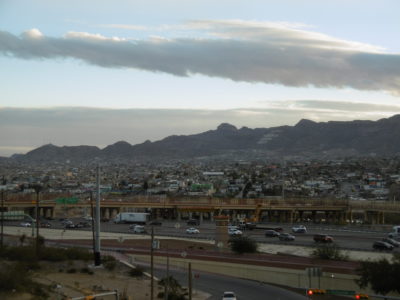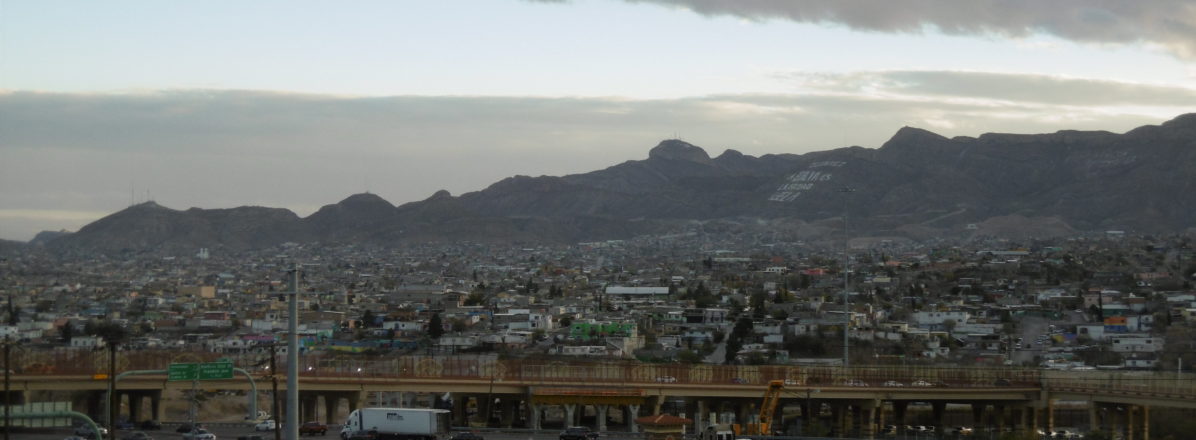A nation must think before it acts.

Ciudad Juarez in early December 2016
“Mexico. It’s unbelievable what’s happened,” President-elect Donald Trump said at an August 10 Fort Lauderdale rally, after warning the audience of the impending departure of 1,400 Carrier Air Conditioning jobs from Indiana. “A friend of mine—he’s one of the biggest in the world at building plants—automobile plants; computer plants; some of the biggest; some of the best—really sophisticated guy; does great.[1]
“So I said to my friend: ‘How is it going?’
“He said: ‘Really great.’
– What does that mean? How’s our country doing?
– Not great.
– Oh. Well, how are you doing great?
– Donald, you have to see what’s going on in Mexico. I’m building plants. So many plants it is unbelievable. What’s going on there is the eighth wonder of the world!
– Mexico? But our country?
– It’s alright. Not great.”
With his conversational anecdote concluded, President-elect Trump offered what he sensed the audience would perceive as a dire prediction. “Mexico’s going to end up being the car capital of the world,” the president-elect asserted, going on to offer his prescription for reclaiming that title for the United States. “When they make a car, we have to say ‘Sorry, folks.’ We have to tax that car as it goes through our border.”
“One of two things will happen,” the president-elect predicted. “Ford is either going to stay, or we’re going to make a fortune. Either one is ok.”
The rally-goers offered raucous applause.
The North American Free Trade Achievement
While deservedly criticizing President-elect Trump for heightening ethnic tensions in communities across the United States with his xenophobic campaign rhetoric, many pundits have overlooked inconvenient truths articulated during Trump’s rallies that may have resonated across broader swaths of the voting American populace. Regardless of whether or not the President-elect’s relayed conversation with his “friend” was an amalgamation of events, a fictive narrative construct, or an actual event, Trump’s description of the situation in Mexico is relatively accurate. Northern Mexico in particular has grown at an “unbelievable” pace since the North American Free Trade Agreement (NAFTA) became law over two decades ago.
In his Fort Lauderdale rally, President-elect Trump implied that Mexico’s economic growth was occurring at the expense of the United States—as though North America’s economy is a zero-sum game, and if Mexico is “winning,” then the United States must be losing. While positioning—even demonizing—Mexico as a formidable economic competitor may have helped Donald Trump get elected, there is little evidence to suggest Mexico’s economic growth is a long-term American problem. Judging strictly on economic data, NAFTA has grown the economy—manufacturing capacity included—on both sides of the border. Based strictly on the numbers, the opposite, in fact, appears true: Mexico’s manufacturing growth runs concurrent with U.S. economic activity, not the other way around.
It is impossible to believe that a man as globally successful in business as Donald Trump does not know this. Despite the tub-thumping and chest-bumping of “bringing back American jobs,” the overwhelming economic success that NAFTA has brought to both sides of the border would make the trade agreement appear likely—in some form—to endure. Even if some American manufacturing jobs remain north of the border—whether Ford Motor Company plants in Kentucky or Carrier Air Conditioning manufacturing in Indiana—it is difficult to conceptualize how two decades of intricate just-in-time supply chains in every facet of consumer goods across three countries and an entire continent would disappear overnight.
U.S. Commerce Department data demonstrate how interconnected the economies of Canada, Mexico, and the U.S. have become. When NAFTA took effect in 1994, the U.S.-Canada trade relationship—the value of imports and exports combined—totaled $243 billion; then, as now, Canada and the U.S. were each other’s largest international trading partners. Similarly, in 1994, the U.S.-Mexico trade relationship totaled just over $100 billion. In 2015, U.S.-Canada trade totaled $577 billion, and U.S.-Mexico trade was $532 billion. Put another way, since NAFTA took effect, U.S.-Canada trade has doubled, and U.S.-Mexico trade has quintupled. Outside of wartime production, this level of sustained economic growth is unmatched in American history.
The Border Looking North
The six Mexican states bordering the U.S. have benefitted in particular from this substantive increase in economic activity. While not quite the eighth wonder of the world, the regional growth, when considered in context, considerably outpaces the rest of Mexico. The official population of these six Mexican states increased 60% during the NAFTA era, from 13.2 million to 21.2 million. Unofficially, the region also became the permanent home of thousands of migrants deported from the U.S. Total estimates, official and unofficial, of foreigners living in Mexico range from one to four million.[2] This number does not count Mexicans displaced internally, who, for any number of reasons, may have remained in the northern states after deportation rather than returning to their original homes, and have not been listed in Mexico’s census by virtue of lacking formal documentation for employment or residence.
Although the state of security on Mexico’s southern border increasingly has become a topic of national concern for its government, little thought has been given, until recently, of the potentially sharp increase in migrant traffic northern Mexico could witness. Should the incoming Trump administration follow through with any number of promised crackdowns, an increase in deportations from the U.S. and more restrictive border controls may create two groups of displaced persons in northern Mexico: deported immigrants from the U.S. and potential American immigrants who avoid attempting to cross the U.S. border and instead choose to remain in Mexico. The north may offer a greater blend of cultural diversity and economic opportunity for migrants with an added potential benefit of prospective follow-on opportunities in the U.S. depending on the ever-changing American political situation.
Setting aside the first group of deportees, how many immigrants would come to northern Mexico to stay? Where would they come from? Current policy favoring asylum requests from Central America in general—especially Guatemala, Honduras, and El Salvador—is unlikely to continue in the Trump administration. Thousands of Haitians—and Africans claiming to be Haitians—have attempted asylum requests and illegal crossings to obtain U.S. residency and may find Mexico a friendlier environment. The largest group of migrants bound for Mexico may come from Venezuela, an economically devastated country whose displaced population may become to the Western Hemisphere what the Syrian refugee crisis is to Europe.
The Border Paradox
Ironically for those who chanted at Trump rallies to build a wall, an average of 350 million legal crossings—more than any other border worldwide—take place on the U.S.-Mexico border each year. Since an increase in Border Patrol agents dramatically reduced the number of people illegally entering the U.S. in California and Arizona, the majority of people who remain in the U.S. without documents do so by overstaying legally obtained visas. The physical construction of a wall along the entirety of the U.S.-Mexico border appears unlikely—especially since two-thirds of the border runs down the midpoint of the Rio Grande and building a wall along the U.S. side of the river would effectively cede the entire waterway to Mexico.
Although Trump highlighted in rallies the trade deficit the U.S. has maintained since 1994 with Mexico as an example of “losing,” the U.S. has endured an ongoing trade deficit with Canada since 1985, with no apparent ill effect on the political or economic relationship. Since unilaterally abrogating NAFTA would devastate both the American and Canadian economies, a U.S. departure from NAFTA seems unlikely to occur. What seems more likely, economically speaking, is the Trump administration’s touting of “success” through relatively insignificant symbolic gestures—such as keeping Carrier Air Conditioning in Indiana—while maintaining business as usual across much of the North American trade enterprise to the mutual advantage of all three nations.
Perhaps the greatest paradox, particularly given the hostility of the campaign, is that unless the Trump administration scraps NAFTA entirely, almost any new policy would work in Mexico’s favor. As Mexico’s energy industry continues to deregulate, increased oil and natural gas exports could bring further economic prospects, especially along the Gulf and to the northeast. If an absence of available labor drives up the cost of goods and services in the U.S.—thus bringing renewed demands from American business owners for a guest worker program—then Mexico’s sustained labor market may step in to fill the void. Tighter U.S. border controls and more immigration enforcement agents will only make Tijuana, Ciudad Juárez, and Monterrey—all of which already have vibrant, diverse immigrant communities—appear that much more culturally attractive to opportunity seekers.
Ultimately, the likely growth of Mexico during Trump’s presidency may wind up disproving a core theory of his anti-immigrant partisans. In his final book Who Are We? The Challenges to America’s National Identity, political scientist Samuel Huntington argued that the immigration wave from Latin America over the past three decades threatened the very fabric of Western civilization. Huntington thought constraining Latin American migration into the U.S. was necessary because that the two political cultures were fundamentally incompatible (Kris Kobach, one of Trump’s immigration policy advisors, was a Huntington protégé.) As Huntington’s disciples assume power, history would suggest they should be careful of getting what they wish for. In the long run, presumption of civilizational superiority rarely seems to end well for those who see themselves as greater. And in the United States, two decades of data suggests that America can be made great with concurrent growth south of the border as well.
[1] Donald Trump’s August 10, 2016 rally in Fort Lauderdale, Florida appears on multiple online video links. The narrative quoted can be found at https://www.youtube.com/watch?v=jRgfaKscvwc and begins at 1:17:32.
[2] Pablo Majluf, “Opinión: México es un destino de inmigración global?” ADNPolítico.com, October 7, 2013, Accessed November 27, 2016.




